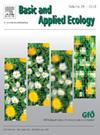Landscape and habitat effects on pest control and seed predation by carabid beetles
IF 3.5
2区 环境科学与生态学
Q2 ECOLOGY
引用次数: 0
Abstract
In both natural and anthropogenic environments, predation by arthropods plays a crucial role in the control of weeds and pests. Carabid beetles (Coleoptera: Carabidae) are key generalist predators feeding on a wide range of prey. The composition and functionality of carabid communities are shaped by multiple factors, both at the local and landscape scale, but these effects can vary depending on the environmental context. Our aim was to explore the effects of landscape composition and local habitat type on carabid community diversity and on insect pest and weed seed predation. We sampled 96 sites belonging to three habitat types (crop field margin, semi-natural and urban green area) selected along a gradient in landscape composition across four regions in northern Italy. Carabid communities were sampled using pitfall traps, insect pest predation was assessed using dummy caterpillars and seed predation was measured using seed cards. Predation rates varied across habitat types, with both pest and seed predation rates decreasing in urban environments compared to crop field margins and semi-natural habitats. Increasing crop areas in the surrounding landscape increased carnivorous carabid diversity and abundance, which in turn increased insect pest predation, while these effects were not observed for seed predation. At the local scale, maintaining semi-natural patches and herbaceous crop field margins, especially in intensive landscapes, represents an effective measure to safeguard carabids and promote the ecosystem services provided by this key arthropod group. However, agricultural expansion at the landscape scale favored carabids and their predation activity indicating that many species are generalist, well-adapted to intensive agricultural landscapes.
景观和生境对瓢虫防治和种子捕食的影响
在自然和人为环境中,节肢动物的捕食对杂草和害虫的控制都起着至关重要的作用。甲甲虫(鞘翅目:甲甲虫科)是主要的多面手捕食者,捕食范围广泛。carbiid群落的组成和功能受到多种因素的影响,包括当地和景观尺度,但这些影响可能因环境背景而异。本研究旨在探讨景观组成和当地生境类型对瓢虫群落多样性以及害虫和杂草种子捕食的影响。我们在意大利北部四个地区沿着景观组成的梯度选择了96个地点,这些地点属于三种栖息地类型(农田边缘、半自然和城市绿地)。采用诱捕法对蛴螬群落进行取样,采用假毛虫法对害虫捕食率进行评估,采用种子卡法对种子捕食率进行测定。捕食率因生境类型而异,与农田边缘和半自然生境相比,城市环境中的害虫和种子捕食率都有所下降。周边作物面积的增加增加了肉食性瓢虫的多样性和丰度,这反过来又增加了害虫的捕食,而这些影响在种子捕食中没有观察到。在局部尺度上,维持半自然斑块和草本作物田边缘,特别是在集约景观中,是保护瓢虫和促进这一重要节肢动物类群提供生态系统服务的有效措施。然而,景观尺度上的农业扩张有利于瓢虫及其捕食活动,表明许多物种是多面手,能够很好地适应集约化的农业景观。
本文章由计算机程序翻译,如有差异,请以英文原文为准。
求助全文
约1分钟内获得全文
求助全文
来源期刊

Basic and Applied Ecology
环境科学-生态学
CiteScore
6.90
自引率
5.30%
发文量
103
审稿时长
10.6 weeks
期刊介绍:
Basic and Applied Ecology provides a forum in which significant advances and ideas can be rapidly communicated to a wide audience. Basic and Applied Ecology publishes original contributions, perspectives and reviews from all areas of basic and applied ecology. Ecologists from all countries are invited to publish ecological research of international interest in its pages. There is no bias with regard to taxon or geographical area.
 求助内容:
求助内容: 应助结果提醒方式:
应助结果提醒方式:


